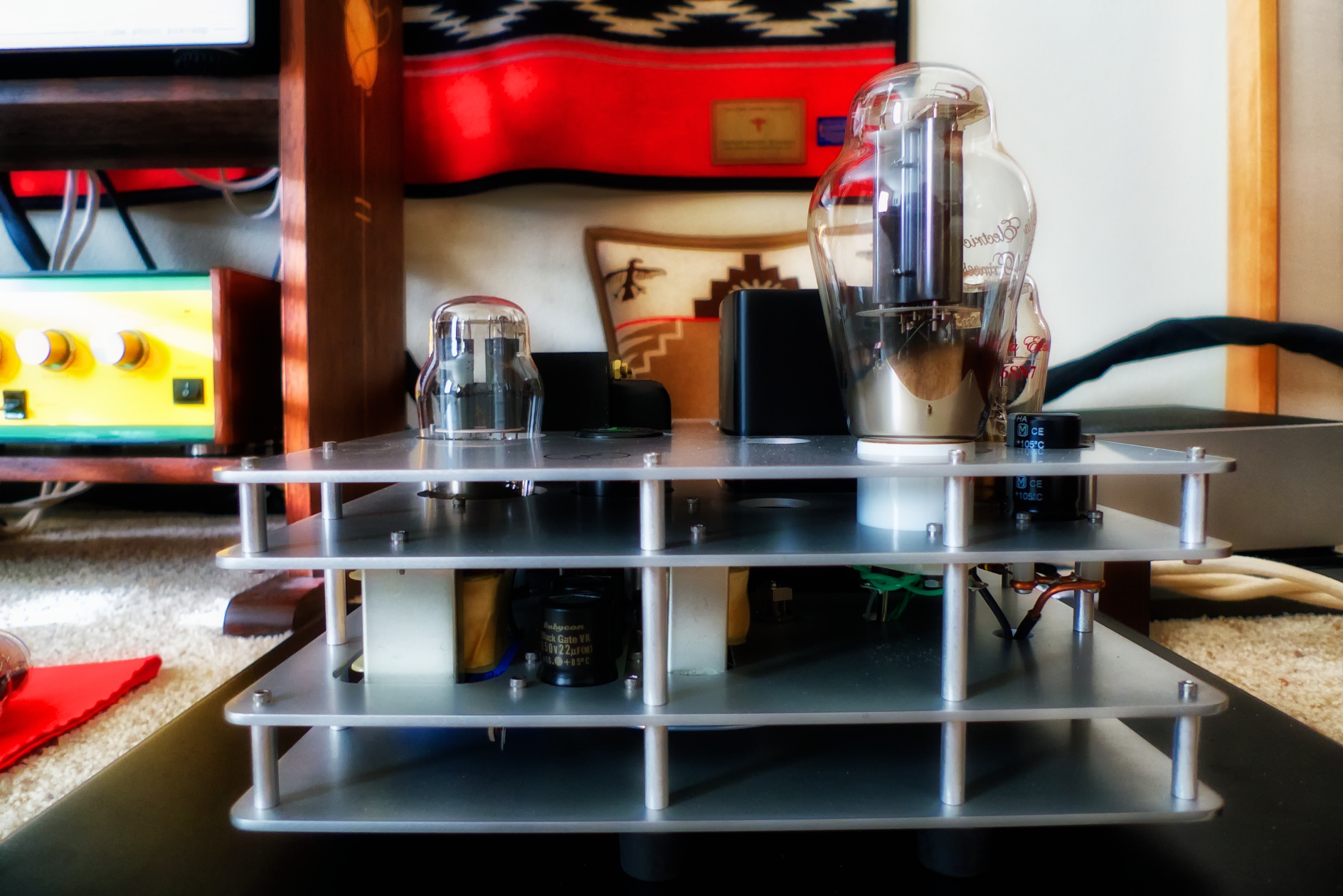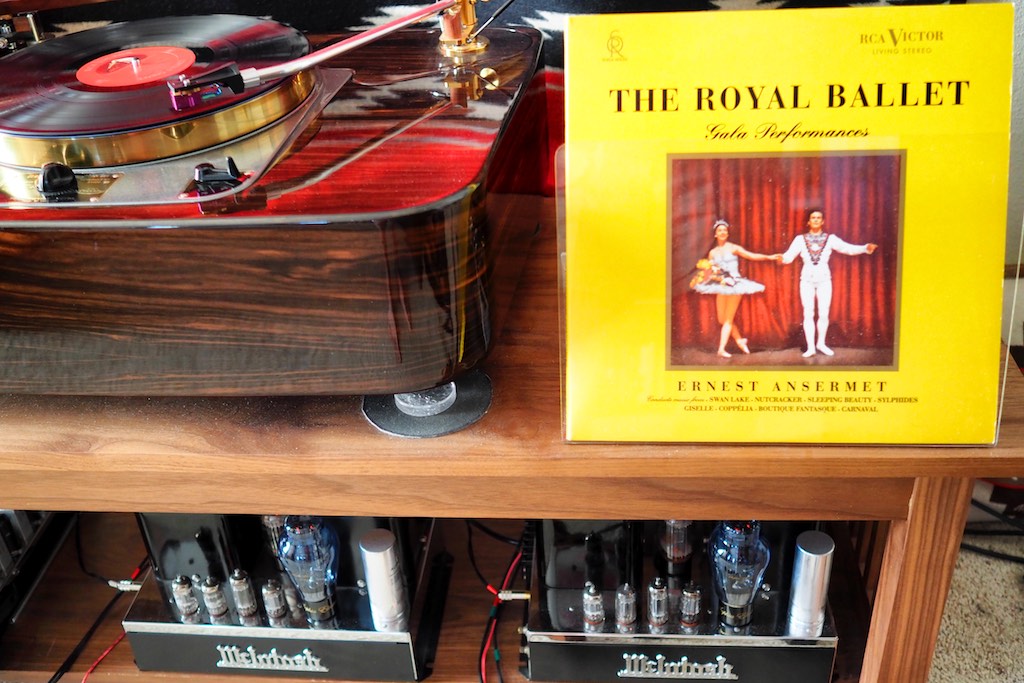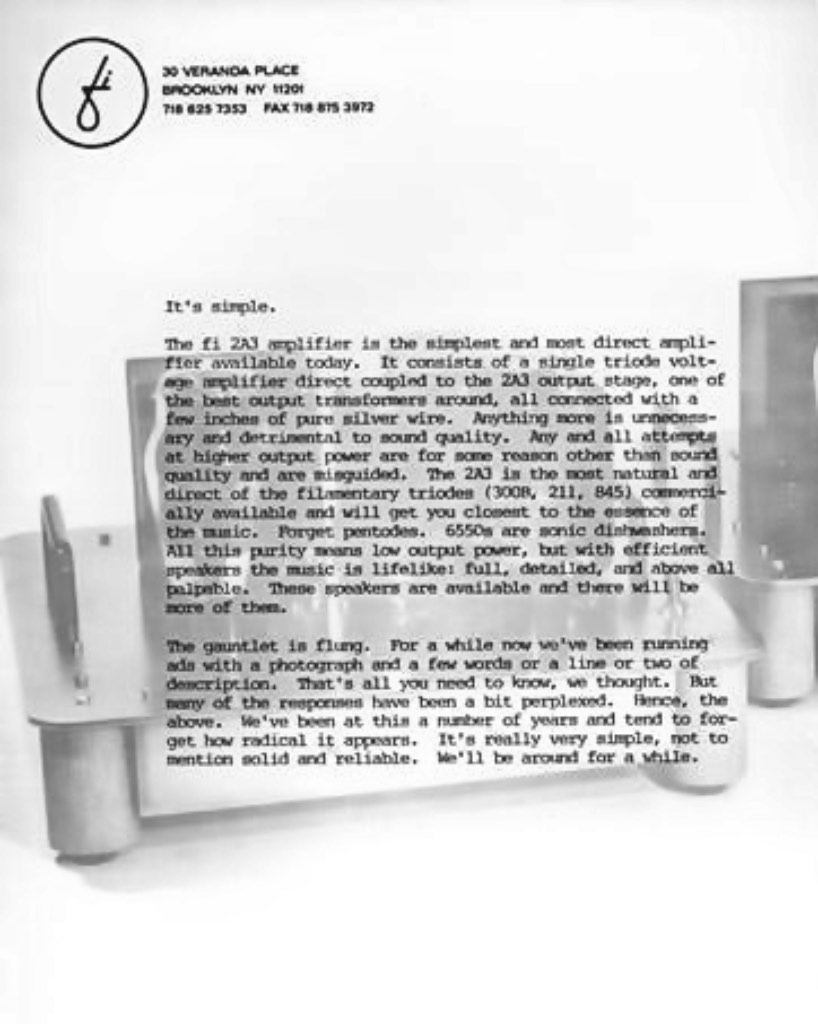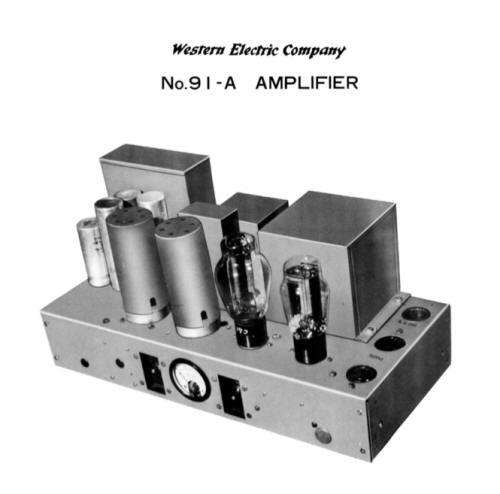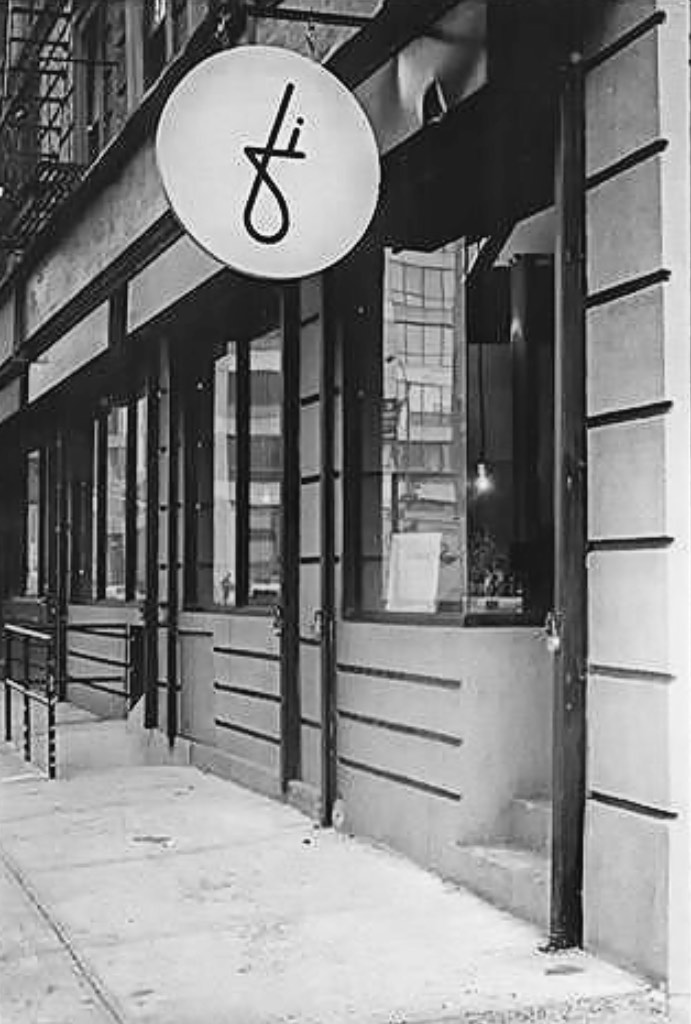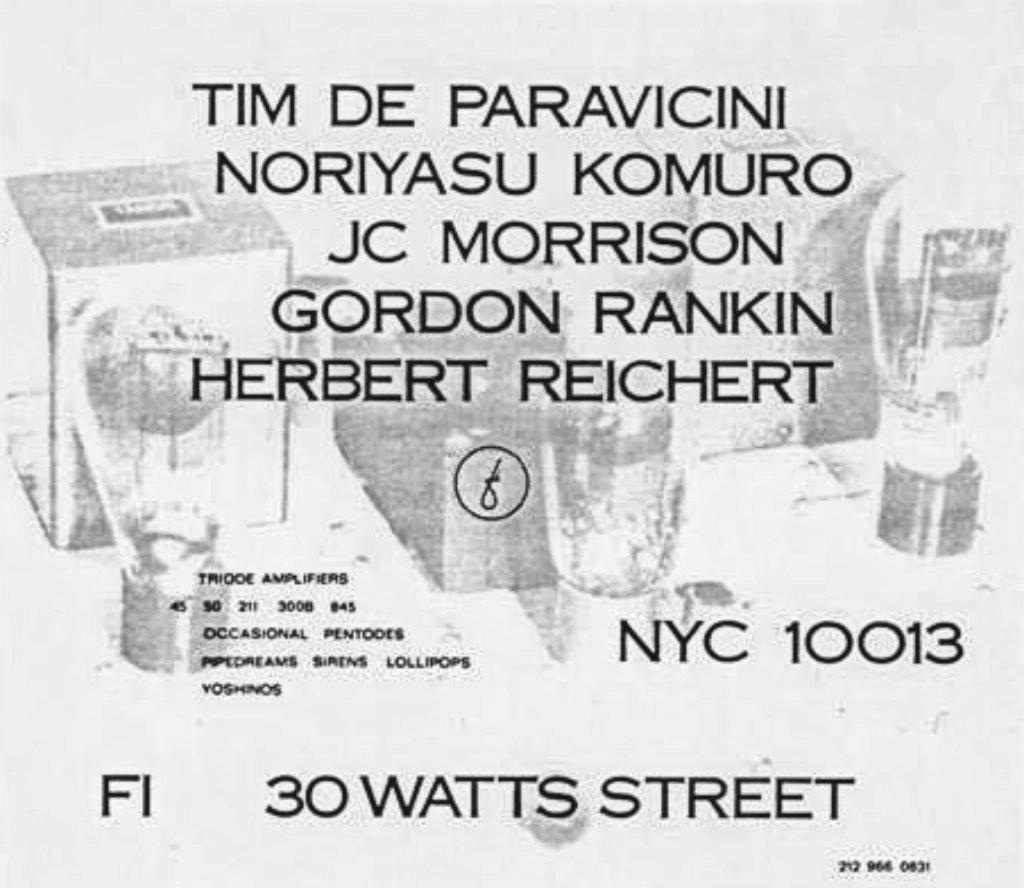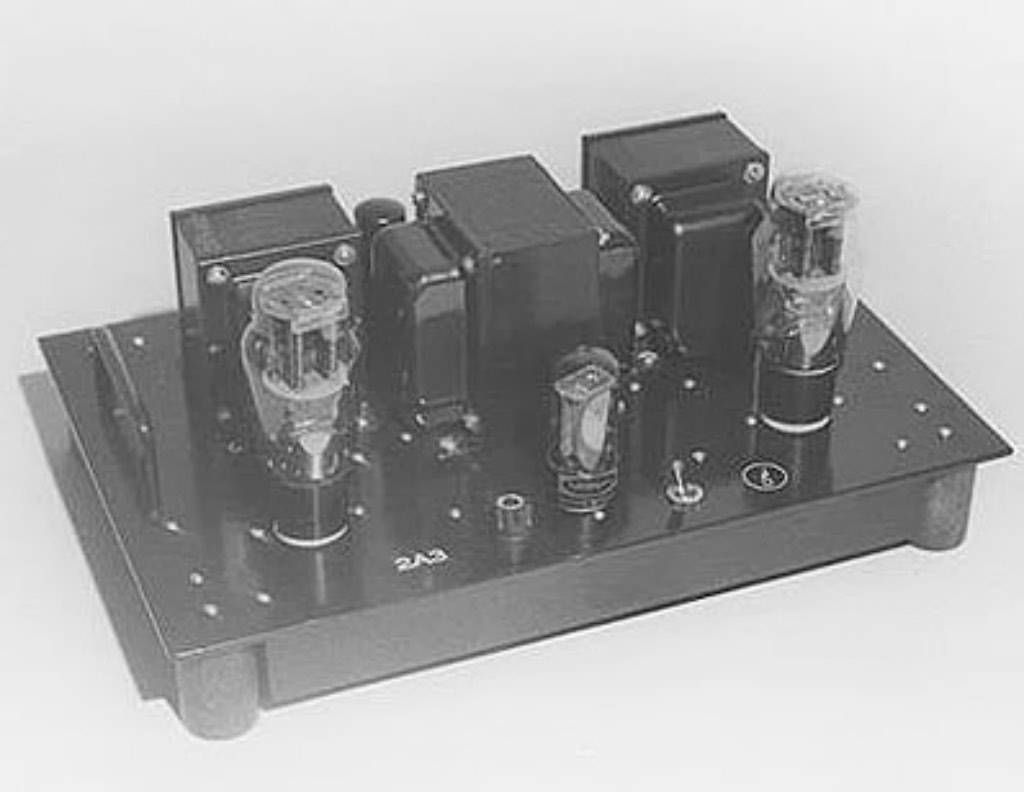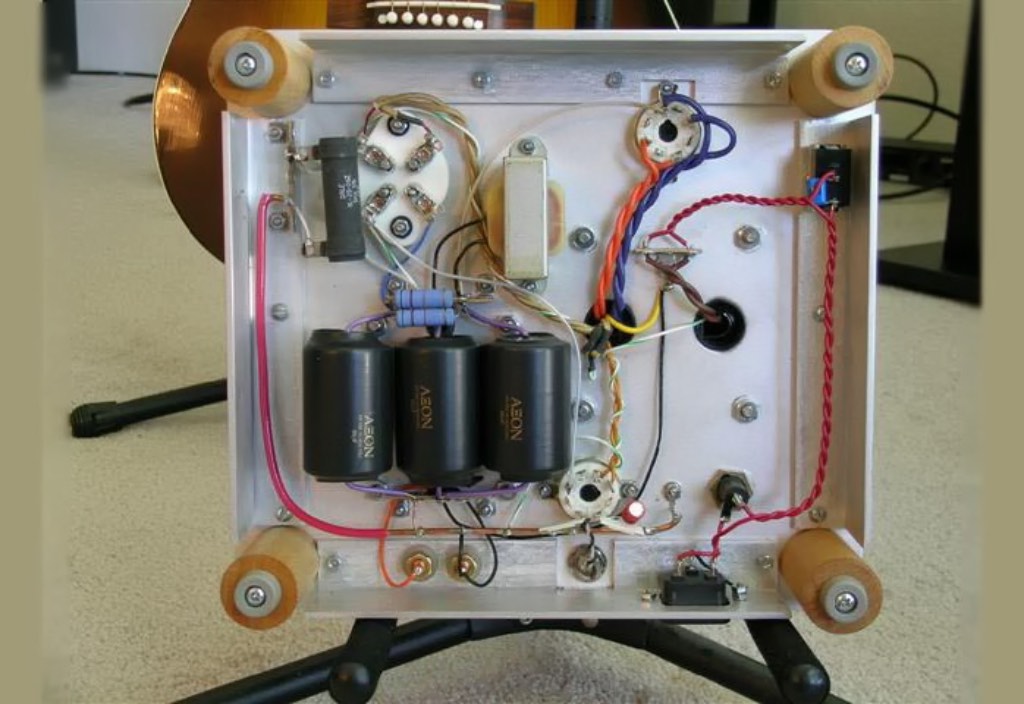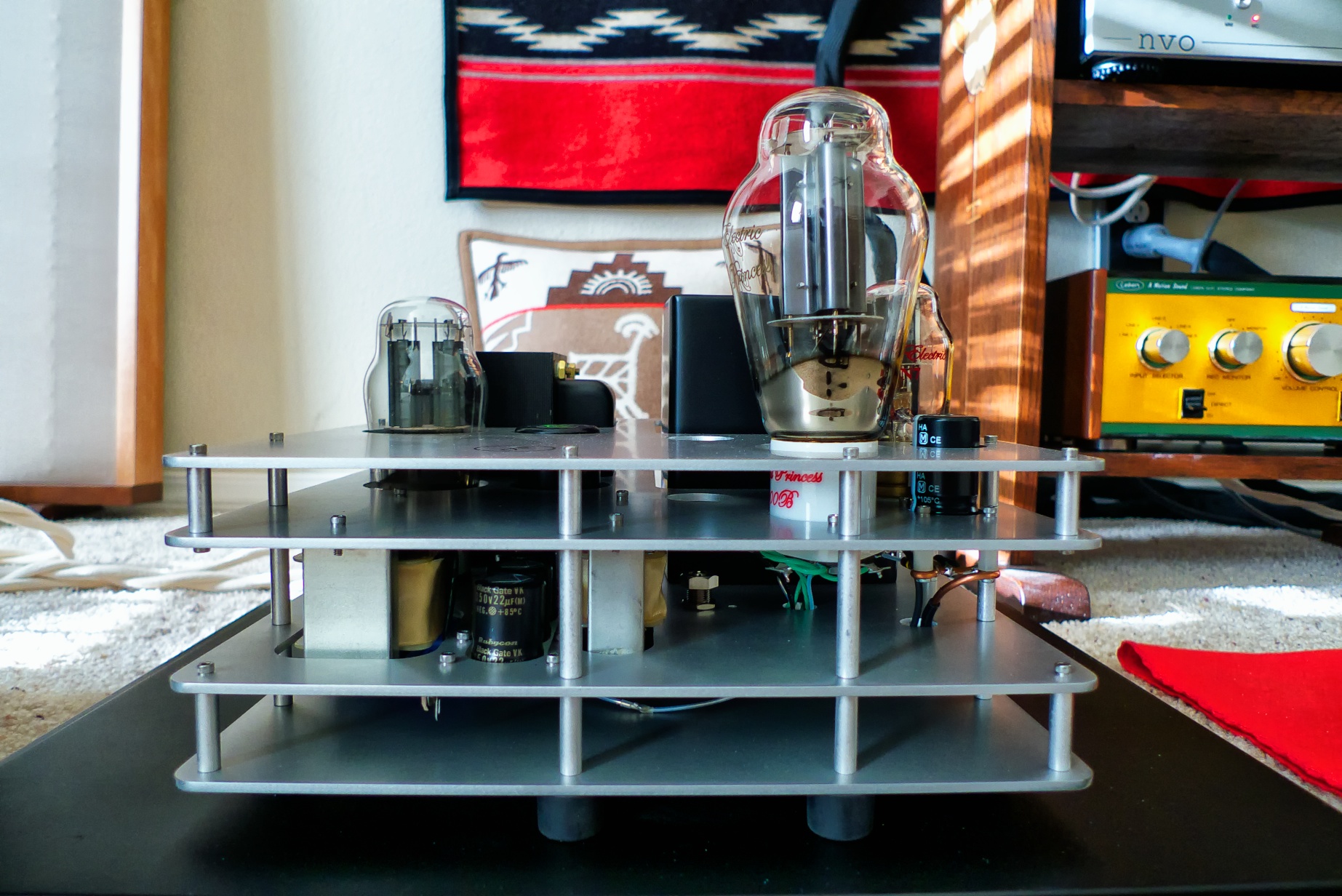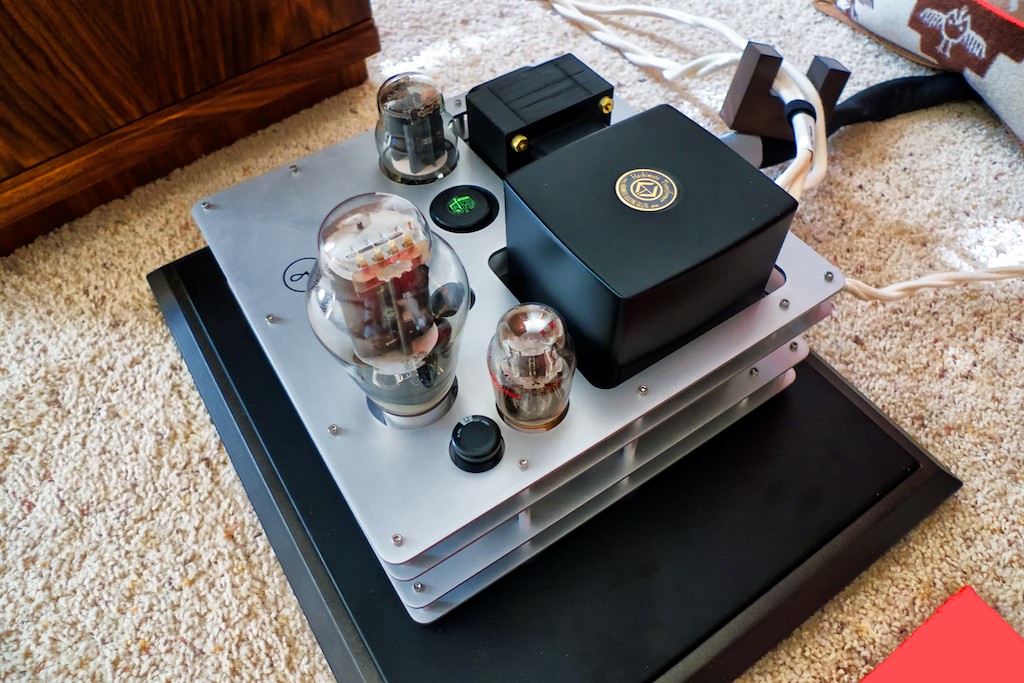As I reported in my earlier post, it is with great sadness that I tell you that Don Garber passed away unexpectedly at his home in Brooklyn on Sunday.
The world will be a less beautiful place without Don Garber in it, and I would like to offer my sincerest condolences to Don's daughter, Nara Garber, and to his two sons, Graham Garber and Pier Gugliotta, for their loss, and I hope you may find some comfort in this difficult time.
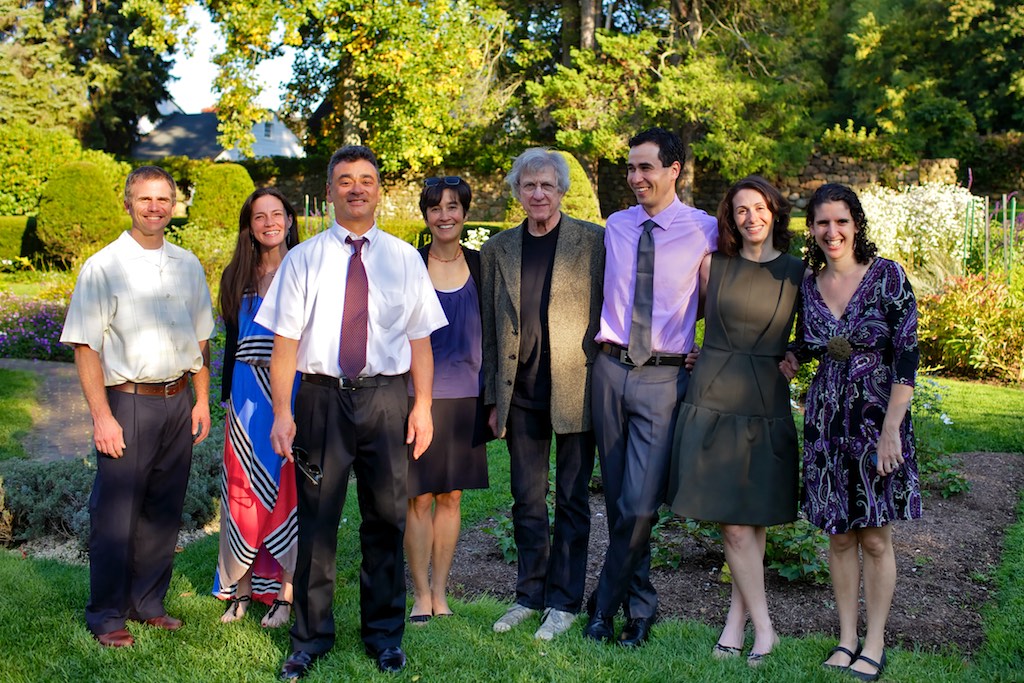
Photo from Nara, Don's daughter. "This is one of the only photographs with Don and all three of us. Pier is in the white shirt and tie, I'm to the right of him, then Don, then my brother Graham in the purple shirt. This was on the day of Graham and Giulia's (to the right of Graham) wedding in October of 2013".
Don's life touched many music lovers and audio enthusiasts, and he was known to many of you reading this for his tremendous contributions to North American audio culture through his fi storefront back in the old days, and later for his fi electronics that were objects of desire for music and audio enthusiasts around the world, not only for their wonderful musical performance, but also for Don's artisanal hand-crafted quality.
I want to offer you some of my remembrances of Don, some things Don shared with me in emails, and some excerpts from earlier articles I that have written about Don, as a memorial article to this wonderful man.
¸¸.•*¨*•♫♪¸¸.•*¨*•♫♪¸¸.•*¨*•♫♪
Don Garber never ceased to amaze me. He was an artist. He was an American cultural treasure for his fi high-fidelity audio designs. Don was also just a neat guy.
It’s no wonder Don’s fi designs have been in such demand that he had over a year’s worth of orders at any given time.
Buying a fi from Don was like receiving a painting from Picasso, or a sculpture from Michelangelo, being infused with life, beauty, and uniqueness.
I bought a number of fi masterpieces from Don over the years, and it was a wonderful experience listening to music with them, admiring Don's fine craftsmanship, and getting to know Don.
Owning fi electronics were much more than just an audio electronics purchase, it was a direct-from-the-artist experience, electronic artwork of the highest order, from Don Garber, an American Audio Master.
In remembrance of Don, I'd like to share with you how I got to know Don, some of our audio adventures, and to tell you some of the history Don shared with me about himself over the years.
I first became aware of Don and his fi audio electronics back in 1996 while working a detail at Congressional Research Service, a policy & legal think-tank group that provides non-partisan policy and legal analysis to committees and Members of both the House and Senate.
One of the staff in CRS loved music and audio as much as I do, and he recommended that I visit "a great little enthusiast audio shop" called Deja Vu Audio in Maclean, Virginia, that always had some really neat audio gear on display, and some great music to play on it.
As you might imagine, I couldn't resist that temptation for long, and soon my wife and I made our way to Maclean, Virginia, to visit Deja Vu Audio for a little audio adventure!
Upon arriving at Deja Vu Audio we were greeted by the charismatic Vu, who showed us a lot of exciting enthusiast audio kit and played some great music for us, in what would turn out to be one of my most memorable and fateful audio experiences ever!
Vu amazed us by playing the Royal Ballet 'Gala Performances' album by Ernest Ansermet, on RCA (which I am listening to now as I write this, in remembrance).
The musical performance was so memorable that it is etched into my heart to this day! What made this musical experience so wonderful?
It was a very small and somewhat fragile looking fi 2A3 stereo amplifier, made by Don Garber in Brooklyn, New York, that somehow miraculously powered a large pair of Spendor SP100 loudspeakers to produce a musical magic from the Royal Ballet 'Gala Performances' LP that was thrilling and astonishing!
I knew I had to have one of Don's fi 2A3 amplifiers in my life! It took a while before I could afford them, just being out of graduate school and newly married, but eventually I saved up enough to order a pair of Don's fi 2A3 monaural amplifiers, which I bought in circa 2004, about a year after I started writing about hi-fi for a then new audio web magazine called 6 Moons, which turned out to be very good therapy after getting divorced!
Over the years I would go on to write numerous articles about Don, his role in North American audio culture, and about his fi audio electronics.
It was during this time that I got to know Don, and I had a ball talking with him about audio, and hearing the stories he told me about his life.
In the Beginning
Don told me about how in the summer of 1957, a fateful meeting took place in Pennsylvania.
He was a young college student, and had let his language requirement for graduation slip while going to school at Penn State. To make up for his oversight, Don put in four semesters of Spanish during the summer at Franklin & Marshall in Lancaster, Pennsylvania, while working a part-time job to pay the bills.
Occasionally Don went to the Oregon Hotel bar to blow off a little steam and take a break from his Spanish studies. The Oregon Hotel was one of a number of backwoods Lancaster County bars known as 'hotels' because that's what most of them had been during their glory days. The Oregon was a great place for college students to hang out because it was close by, had a great bartender, and the low light levels gave a cool blue tint to everything inside.
One night Don ran into John Grosh, who was a research engineer at the now long-defunct RCA research labs in Lancaster, that produced vacuum tubes for the military in World War II, and which after the war grew and became the primary research & development and production facility for RCA vacuum tubes, which are prized by audio and music enthusiasts to this day.
John was at the bar conversing in Spanish with a couple of migrant workers that came in most evenings. Don took this as an opportunity to practice his Spanish - ahem, among other things - and joined in on the conversations.
One night Don told John that he wanted to get into hifi, but didn't know how to go about it. John told Don he should build his own hifi gear, and recommended that Don start with a Heathkit W5-M, a 25-watt amp based on KT66 tubes.
This was before stereo so the kit was a mono amplifier. When stereo became popular, Don put his new-found kit building skills to work and built another W5-M for a stereo pair.
Over time, Don relegated the W5-Ms to the closet and replaced them with transistor gear "like everyone else had".
In the late 1980s or perhaps early 1990, Don realized that his solid-state gear didn't sound too good, so Don got out his old W5-M amplifiers and found that they sounded better.
While Don was thinking about how his transistor gear was bested by his old W5-M amplifiers, his friend John called up Don to tell him about his "new" Western Electric 91-A amps.
John had just been given a pair of Western Electric 91-A 300B movie theater amplifiers by a friend who worked at Bell Labs. John said "You've got to hear this!"
Don met with John to hear the Western Electric 91-As. They were "nice and scabby looking," recalls Don, "and looked like they'd been strapped onto projectors for 30 years and probably had been."
When they fired up John's system with the Western Electrics, it sounded great and more importantly, played music with abandon.
Nobody was building SETs in North America yet. Herb Reichert and JC Morrison - who would later become famous for their work with SETs - were devotees of the work of Arthur Loesch at the time.
Then Noriyasu Komuru started building amps, as did Gordon Rankin, and Don was experimenting with 2A3 amplifiers.
Once the fires of SETs had again been lit it began to burn into the consciousness of North American enthusiast audio.
News of SETs began to percolate into the American hifi scene, nicely coinciding with the beginning of a trend of an increasingly disgruntled audio everyman who saw prices for good quality equipment spiral out of financial reach. In the 1970s, high quality audio was perceived to be generally available to a wide economic cross section of the populace and many could share in the fun with some sense of equity.
As the economic gap between consumer audio and high performance audio widened in the 1980s and 1990s, an audio high end evolved with an image of providing toys for the rich and excluding the audio everyman who wanted to join in the fun.
The audio everyman wanted more access to good gear and less exclusionary pricing, more fun and camaraderie in the hobby, and less snobbery and aloofness, more "sound of live music" reality, and less emphasis on hifi sound effects - and they considered cheapness an essential virtue.
In 1992, Don saw a little storefront for rent on 30 Watts Street while out for a walk through Soho in Manhattan, a little triangular space that he thought was pretty nice.
Don rented the store and fixed it up and called it fi, which was short for hifi, and began to resell vintage gear and the first single-ended amplifiers made in America.
There was a placard in the window that read:
Don told me, that by that time Herb Reichert had built a 300B amp that he had in the store, and JC Morrison built a 6B4G (like a 2A3) that was in a big mahogany plinth with black powder-coated chassis that was really attractive. JC also made it available in an EL34 version. It was a beautiful amplifier but it never sold. About that time Gordon Rankin built an 845 amplifier and it sold, and Don told me that if recollected correctly, it was Gordon's first SET sale.
People drifted in and out of fi, with Noriyasu Komuru the only one who stayed around to actually work the store with Don for a while.
The fi store was making enough money to stay open but not really enough to make it worthwhile for all the work involved.
About that time, the Sound Practices magazine was launched and Don advertised in it and sold two more amplifiers to enthusiasts on the West Coast.
Don's first Sound Practices advertisement featured designs by Tim de Paravicini, Noriyasu Komuro, JC Morrison, Gordon Rankin and Herb Reichert. It proclaimed: "Triode amplifiers (45, 50, 211, 300B, 845), occasional pentodes, pipedreams, sirens, lollipops and Yoshinos".
The Birth of the fi 2A3 Stereo Amplifier
Don began to think that he might be able to do better by just selling amplifiers, as he had been experimenting with 2A3 circuits, and tried just about every circuit extant. He finally found one he really liked and began to make it simpler and simpler. Every time he made it simpler, it sounded better.
Once Don settled on the final circuit, he made his first product for sale in the store: The fi 2A3 Stereo. That first amplifier sold for $1475 and was bought by a New Yorker who walked in off the street, listened to the amplifier, liked what he heard and bought it on the spot.
A flyer for the original fi 2A3 Stereo described Don's designs at the time: "The fi 2A3. Single ended, direct coupled, silver wired. Handmade to order."
"fi began as a result of hearing a single-ended triode amp quite a few years ago. Much water over the dam and few regrets later, I've filtered out a few working hypotheses and a sort of direction."
"It seems to me that simplicity (often doubted and usually achieved by the most roundabout means) yields the most natural and truest results. This is what I hear and I can only guess why. This gives you a very low-power amplifier (in my case a direct-coupled 2A3)."
"Maybe it's the fear of being taken for some kind of fool or the desire for a broader appeal, but it seems the designer's first reaction to the SE triode amp is to find some way to boost the power. I know. I've tried and I've listened to a lot of the paralleled amps, triode connected pentodes and so forth and the best I can say is 'not bad'. It seems to me that the power quest is a step backward."
"The real need is efficient speakers. I'm very pleased with my 95 dB/W/m system (If I remember correctly, at the time Don told me he had Altec Lansing 604 duplex speakers in some nice big cabinets - Jeff). What it does well it does to perfection but it won't do everything - not Mahler as if you were standing on the podium (if that's your taste). There are a number of possibilities over 100dB available now and there will be more soon. "
"Silver. The more the better. I've had MagneQuest's new all-silver outputs for three days as of this writing and they are opening up by the day. All descriptions come back to 'natural'. I try to build as simply, directly and as elegantly as possible and price accordingly. It seems putting the price in the stratosphere does appeal to some but I suspect it's eventually counterproductive."
As Don continued to build amplifiers, the Fi 2A3 Stereo continued to undergo refinements. The round-cornered black Fi Stereo was another step in the early evolution of the Fi 2A3. An early flyer describes this stage of the Fi 2A3 development.
The flyer for the black round-cornered fi 2A3 read, "The fi 2A3 is the result of a search for the purest, simplest and most elegant single-ended amplifier. It's direct-coupled, which is to say there are no coupling capacitors. The signal path consists of a 6SF5 single triode driver (nothing paralleled), a 2A3 directly heated triode, a MagneQuest DS025 output transformer and a few inches of silver wire. The only shared elements in the power supply are the power transformer (contract-built by Thordarson) and the 5Y3 rectifier.
Each side has its own filter network (SCR polypropylene capacitors and Dale wire-wound resistors) and each 2A3 has its own filament transformer. It's a very open, relaxed, dynamic and detailed amplifier. The price is $1475 with a two week money-back guarantee if returned in original condition. A 50% deposit is required to order, the balance payable upon delivery. Delivery in 30 days or less. 3 watts."
Don tested all the components used in his amplifiers by ear. In an amplifier, Don said the coupling caps usually have the biggest influence on the sound. The fi amps are direct-coupled so there are no coupling caps that can affect the sound. With coupling caps not being a factor, the circuit is responsible for 95% of the sound you hear. Don continued to refine his amplifiers. The first resistors he used were Allen Bradley film resistors. Don then went to Caddock resistors because he thought they sounded better, but the basic circuit has remained unchanged. Don told me his grounding scheme evolved to make the amp quieter. It's a direct-heated, direct-coupled amplifier with AC on the filaments so it's a little bit noisy. Don tried to warn potential buyers ahead of time about the hum so they'd know what to expect.
fi evolves and expands
After the success with the fi 2A3 stereo amplifier, Don went on over the years to develop many more successful audio designs, like the fi 2A3 monaural amplifiers (which I owned) ...
... the fi 300B monaural amplifiers (which I also owned) ...
... the fi preamplifier (which I lusted after but couldn't afford) ...
... a fi Western Electric 421A stereo amplifier, a fi X 2A3 stereo amplifier, a fi Super X 2A3 stereo amplifier, a fi Y line preamplifier, and a fi Yph phono stage, to name a few.
I kept asking Don when he was going to build a proper fi website to show off his creations, and he told me, "I already have a website in the articles you wrote, I don't need anything else!"
I would also get emails from time-to-time from Don with photos of a new design he had built, and was thrilled with, like the fi 46 mono amplifiers that he’d just put the finishing touches on for New Year's in 2012.
Don told me, "... they put out a measly 1.5 Watts (how’s that for salesmanship?). I’m not very good at verbal descriptions of sonics, but I like them better than anything I’ve done yet, even though my current Altec speaker setup (95-96dB) is not as efficient as it should be for them. Happy New Year! Regards, Don."
Then there was the time Don sent me a photo of a prototype 300B integrated amplifier he built with the 3-D chessboard-style chassis. What a beauty!
I still lust after that prototype, it pushed all my audio buttons!
Don has been a major influence in my musical and audio life, and his love of his Garrard 301 turntable, single ended triode amplifiers, and Altec loudspeakers still inspires me today!
Don, I'm really going to miss you, your wit, your humor, your art, your artisan fi electronics, your emails telling me about your latest creations, or reminiscing about audio days gone by, your inspiration, all of which enriched my life immeasurably.
You made a big difference in so many of our lives, I wanted to take a moment to reflect on the parts of yours you shared with me, and wish you Godspeed my friend!
¸¸.•*¨*•♫♪¸¸.•*¨*•♫♪¸¸.•*¨*•♫♪
Please join me in leaving your thoughts and memories about Don Garber here to celebrate his life and memory.




